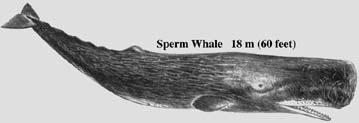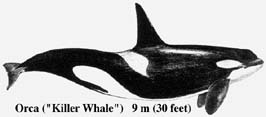Whales and their Ancestors
Whales and their Ancestors
Based on Dr. Thewissen's excellent public access pages
We highly recommend you visit this external site at: http://www.neoucom.edu/DEPTS/ANAT/Thewissen/whale_origins/
Whale Ancestors
Ambulocetidae - The First Costal
Whales
Basilosaurids and Dorudontids
Mysticetes
Odontocetes
Pakicetidae - The First Whales
Protocetids - First whales to disperse widely
across the world's oceans
Remingtonocetidae - Whales Endemic to the
Indian Subcontinent
Some Modern Whales
Whale Ancestors
Scientists have long known that cetaceans (whales, dolphins, and porpoises) descended from four-footed land mammals. Cetaceans still have some features of land mammals; they use lungs to breathe air and give birth to young that are nursed by milk produced by the mother. Modern cetaceans cannot live on land, and look very different from land mammals in most respects.Cetaceans evolved rapidly, and the entire transition from land mammal to obligate marine whale took less than 8 million years. These Eocene cetaceans are often called archaeocetes, and they can be divided into six families: Pakicetidae, Ambulocetidae, Remingtonocetidae, Protocetidae, Dorudontidae, and Basilosauridae. It is only since the 1990’s that relatively complete skeletons of the archaeocetes have been found in abundance and that the transition from land-to-water could be studied in detail.
Until the early years of the 21st century, most paleontologists thought that cetaceans were most closely related to mesonychians (The Mesonychian Hypothesis). Mesonychians are an extinct (Paleocene-Oligocene) group of hoofed mammals from the Northern Hemisphere. They varied in size from that of a weasel to a grizzly bear, and may have eaten carrion or meat. Unlike paleontologists, most scientists studying DNA were of a different opinion. They considered hippopotamids as the closest relatives to cetaceans (The Hippopotamid Hypothesis). Hippopotamids (including the recent Hippo and the Pygmy Hippo) are included in a group of mammals called even-toed ungulates or artiodactyls. Other artiodactyls are: pigs, peccaries, camels, llamas, giraffes, deer, goats, sheep, cattle, and antelopes.
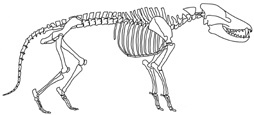
Skeleton of a mesonychian.
In 2001, two important skeletons of pakicetids, found by the Thewissen-lab, were described (see Pakicetidae for images). These skeletons helped to change our opinions on what the closest land relatives of cetaceans were. Data gathered from the new pakicetid skeletons show that mesonychians are not the closest relatives of cetaceans (sister groups in scientific lingo). However, these new data also disagree, less strongly, with the sister group relation between hippos and cetaceans championed by the molecular scientists. Instead, the new data are most consistent with close relationships between whales and all of artiodactyls, the Artiodactyl Hypothesis. To understand the differences between these hypotheses, let's compare the relations of these groups of animals to those of a number of female members of a human family. Let's say that we are trying to describe the relation of Celia to her relatives Heidi, Arlene, and Megan, and we know that all are from the same generation.
It could be that Celia is a first cousin to Megan, and that Heidi and Arlene are sisters of each other, but only distantly related to Celia and Megan. If we indicate maternal relations only, the following branching diagram would apply:
MESONYCHIAN HYPOTHESIS
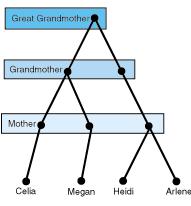
It could also be that Celia is a sister to Heidi, and that Arlene is their first cousin. Megan is more distantly related.

Finally, it could be that Heidi and Arlene are sisters, Celia is their first cousin, and Megan more distantly related.
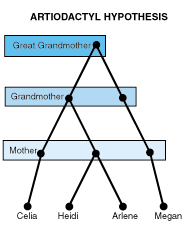
These diagrams explain the essence of the differences between the three competing hypotheses for cetacean relations. Substitute Cetacea for Celia, Hippos for Heidi, other artiodactyls for Arlene, and mesonychians for Megan, and a simplified version of the scientific argument surrounding cetacean origins emerges.
Ambulocetidae
The First Costal Whales
The skeleton of Ambulocetus natans
(approximately 12 feet long)
To see a flesh-and-blood reconstruction go to Carl Buell's painting.
Ambulocetids are large, powerful animals, with short limbs, but big feet, and a strong tail. They are only found in northern Pakistan and western India in rocks that indicate that the environment was nearshore marine and swampy. These rocks cannot be dated with great accuracy, but they are clearly younger than the sediments in which pakicetids are found. Although ambulocetids could walk on land as well as swim, it is clear that they were not fast on either terrain. The post-cranial skeleton of ambulocetids is well known thanks to the discovery of a very complete skeleton of the species Ambulocetus natans. The name of this whale means “the walking and swimming whale,” and indicates that it was amphibious. Ambulocetus was first described by Thewissen et al. (1994), and later, in more detail, by Thewissen et al. (1996)
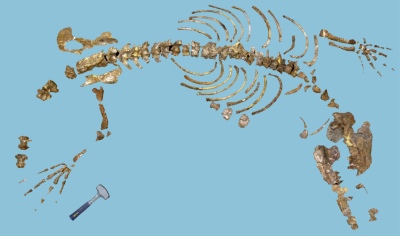
The bones of Ambulocetus natans arranged in its approximate body shape. These are the original fossils, all pertaining to a single individual. Note hammer for scale.
Three genera of whales make up the family Ambulocetidae: Ambulocetus , Gandakasia , and Himalayacetus . Gandakasia and Himalayacetus are only known from a single lower jaw fragment each, and cannot be compared in detail with Ambulocetus .
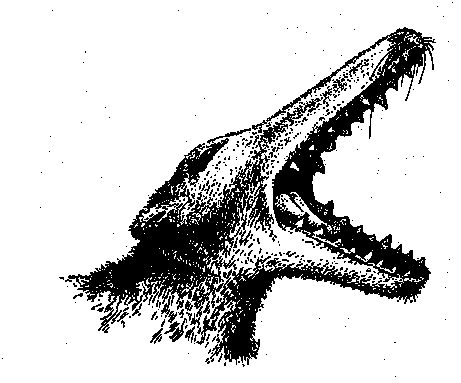
Head of Ambulocetus as drawn by Marion Lipka
Some publications on ambulocetids:
Thewissen, J.G.M., S.T. Hussain, and M. Arif. 1994. Fossil evidence for the origin of aquatic locomotion in archaeocete whales. Science 263:210-212.
Thewissen, J.G.M., S. I. Madar, and S. T. Hussain. 1996. Ambulocetus natans, an Eocene cetacean (Mammalia) from Pakistan. Courier Forschungs-Institut Senckenberg, 190:1-86.
Thewissen, J.G.M., and F. E. Fish. 1997. Locomotor evolution in the earliest cetaceans: functional model, modern analogues, and paleontological evidence. Paleobiology 23:482-490.
Madar, S.I., J. G. M. Thewissen, and S. T. Hussain. 2002. Additional holotype remains of Ambulocetus natans (Cetacea, Ambulocetidae), and their implications for locomotion in early whales. Journal of Vertebrate Paleontology 22:405-422.
Basilosaurids and Dorudontids

Reconstruction of Basilosaurus cetoides (top) and Zygorhiza kochii (not to scale). There are several inaccuracies in this old reconstruction (Kellogg, 1936), such as the exact number of vertebrae and the shape of the forelimbs. Discovery of new specimens has made it possible to correct these.

Basilosaurids and dorudontids lived in the late Eocene, approximately 35 and 41 million years ago. They are mainly known from the eastern United States and from Egypt, but were probably worldwide in their distribution. Basilosaurids were enormous (possibly up to 60 feet long) and had long snake-like bodies. They had a tailfluke, but they probably swam using sinuous movements with their bodies. it is not clear whether that was the main propulsive organ. Fossilized stomach contents in one Basilosaurus indicates that it ate fish, including sharks. Dorudontids are closely related to basilosaurids but were proportionally more like dolphins. They probably swam using their fluke. Both basilosaurids and dorudontids had complete hindlimbs, that included a mobile knee and several toes. However these extremities were tiny, so small that they were certainly not important in aquatic propulsion.
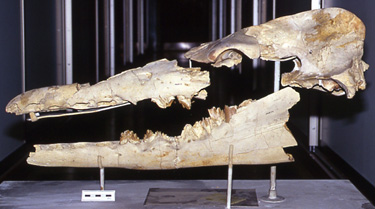
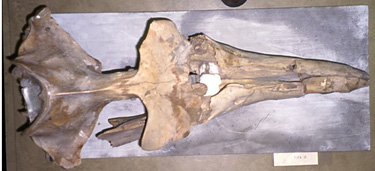
Two skull views of a dorudontid in the Natural History Museum of London
For more information on basilosaurids and dorudontids, visit http://www.archaeocete.org/
Mysticetes

Skeleton of a right whale from Weber, 1928. B indicates bones of pelvis and thigh.
Modern whales, dolphins, and porpoises and all their fossil relatives are together included in Cetacea.
Modern Cetacea fall in two categories, called suborders: the Odontoceti (toothed whales) and Mysticeti (baleen whales).
There are about 10 modern species of baleen whales, including the right whale, blue whale, and humpback whale. These whales lack teeth, and instead have a curtain of baleen hanging down from their upper jaw. Baleen is a hair or horn-like substance which forms a sieve that filters water. Also, their skull is characteristically modified by the anterior displacement of the bones that form the back of the skull combined with the posterior displacement of the bones that form the front of the skull.
Baleen whales are known for their long wailing songs which carry hundreds of miles. They include the largest animal ever living on earth, the blue whale.
Many species of mysticetes have been driven to near extinction by whalers. Recent international treaties have been somewhat successful in saving these species, although some are still quite rare (balaenids). The oldest mysticetes are about 40 million years old and are derived from Eocene cetaceans.
The suborder Mysticeti includes the baleen whales, such as right whales, blue whales, and humpback whales. These whales lack teeth, and instead have a curtain of baleen hanging down from their upper jaw. Baleen is a hair or horn-like substance which forms a sieve which is used to filter water. Baleen whales are known for their long wailing songs which carry hundreds of miles. They include the largest animal ever living on earth, the blue whale. Many species of mysticetes have been driven to near extinction by whalers. Recent international treaties have been somewhat successful in saving these species, although some are still quite rare (balaenids). The oldest mysticetes are about 40 million years old and are derived from Eocene Cetaceans.
Characters of modern mysticetes
- Baleen plates No teeth
- Bones from back of skull moved forward (telescoped)
TWO BALEEN WHALES, NOT TO SCALE
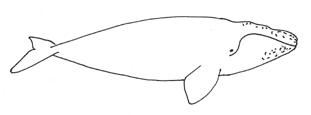
Right Whale
Balaena glacialis
Length up to 58 feet ( 18 meters)
Weight up to 100 tons (90,000 kg)

Blue Whale
Balaenoptera musculus
Length up to 90 feet (28 meters)
Weight up to 200 tons (140,000kg)
Odontocetes

Skeletons of two dolphins, the Indo-Pacific Hump-Backed Dolphin, Sousa chinensis (top) and Risso's Dolphin, Grampus griseus. Redrawn from Howell (1930)

Odontoceti (Latin for toothed whales) include dolphins, porpoises, as well as a number of larger whales such as sperm whales, beaked whales and belugas. Most odontocetes live in the ocean, but a few species of dolphins live in rivers. There are coastal and deep-sea species, some are tropical and others polar. Some odontocetes, such as the killer whale, inhabit all climate zones of all oceans.
Odontocetes are active hunters of large prey items. Prey may include fish, squid (sperm whale), or mammals such as sealions and cetaceans. Most odontocetes have teeth, and these are spatulate or peg-like. The skull of odontocetes is modified: it is asymmetrical and the bones of the forehead are displaced posteriorly.
Unlike mysticetes, odontocetes echolocate; they emit high frequency sounds and determine shapes in their environment by listening to the reflections of these sounds. To accomplish this, they have a sophisticated sound emission system located in the forehead, and consisting of a number of air-filled cavities that are connected to the nasal cavity. In addition, the forehead has a fatty lense-shaped organ called the melon. This organ gives the dolphin head its characteristic shape and functions as an acoustic lense. The ears of odontocetes are highly specialized for the reception of reflected echolocation signals The largest odontocete is the sperm whale. The oldest odontocete is approximately 40 million years old and is derived from Eocene cetaceans.
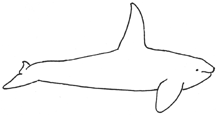
Killer whale
Orcinus orca
Length up to 31 feet (10 meters)
Weight up to 9 tons (8200 kg)

Sperm whale
Physeter macrocephalus
Length up to 60 feet (19 meters)
Weight up to 50 tons (45,000 kg)
Ambulocetids show more aquatic adaptations than pakicetids, and probably filled an ecological niche similar to modern crocodiles. They are found in near shore environments and probably ambushed part of their prey in the shallows. They could move both on land and in water, and had robust jaws and teeth to handle large struggling prey. The post-cranial skeleton of ambulocetids is well known thanks to a nearly complete skeleton of the species Ambulocetus natans that was found in northern Pakistan. Ambulocetids are only known from Eocene deposits of Pakistan, 49 million years ago. Some current research on ambulocetids focuses on their locomotor adaptations.
Genera of Ambulocetidae
- Ambulocetus
- Gandakasia
- Himalayacetus
Characters of Ambulocetidae
- Pterygoid process same height
as braincase - Medially placed, laterally
facing orbits - Medium-sized mandibular foramen

Head of Ambulocetus as drawn by Marion Lipka
Pakicetidae
The First Whales
A reconstruction of Pakicetus, based on the skeletons below. This reconstruction can be used freely, but this statement has to be added to its caption: Illustration by Carl Buell, and taken from http://www.neoucom.edu/Depts/Anat/Thewissen/whale_origins/whales/Pakicetid.html.
Pakicetids were the first cetaceans, their fossils are only found in northern Pakistan and western India, and the best fossils are from a locality in the Kala Chitta Hills in Punjab, Pakistan. The Indian subcontinent is probably the region where cetaceans originated. Pakicetids did not look like whales at all, and resembled land mammals. However, the skulls of pakicetids have an ear region that is highly unusual in shape, and only resembles that of modern and fossil whales. These features are diagnostic for cetaceans, they are found in all cetaceans, and in no other animals. These features are main why pakicetids are considered whales. In many other features, pakicetids are also similar to some whales, but those features are not shared by all whales. An example of the latter is the dentition. Pakiceid teeth look a lot like those of fossil whales, but are unlike those of modern whales. Pakicetids did not live in the sea. The rocks in which their fossils are preserved indicate that the bones were buried in a shallow stream, and that the climate was hot and dry. It is likely that pakicetids waded in these streams. Their bones are unusually thick, possibly an adaptation to make the animal heavier counteracting the buoyancy of the water.

Photograph (above) of bones of Pakicetus (large animal) and Ichthyolestes (small animal), and a line drawing of the same skeletons. The hammer indicates the size of the skeletons, and shows that Pakicetus was approximately as large as a wolf, and Ichthyolestes is as large as a fox.
The family Pakicetidae (pakicetids in English) consists of three genera, Pakicetus, Nalacetus, and Ichthyolestes. Of these, Pakicetus was the largest, and Ichthyolestes the smallest. In overall shape, these three are not very different. The skeleton of pakicetids was described by Thewissen et al. (2001). In evolution, pakicetids were followed by ambulocetids.
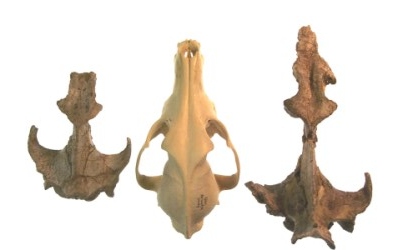
The skulls of two pakicetid whales flank the skull of a modern coyote ( Ichthyolestes on the left, Pakicetus on the right). These skulls were described by Thewissen et al. (2001).
Pakicetid fossils were important in determining what whales were related to, and they were used to rebuke the idea that whales were closely related to an extinct group of hoofed mammals called mesonychians. These fossils confirmed what was already suggested by scientists studying the DNA of modern whales: that whales’ closest relatives are even-toed ungulates (artiodactyls, such as pig, hippo, camel, deer, and cows) Current research in the Thewissen lab attempts to determine how sound was transmitted through the pakicetid ear and how pakicetids locomoted in water and on land.
Some publications on pakicetids from our lab:
Maas, M.C. and J. G. M. Thewissen. 1995. Enamel microstructure of Pakicetus (Mammalia: Archaeoceti). Journal of Paleontology, 69:1154-1163.
Thewissen, J. G. M., and S. T. Hussain. 1998. Systematic review of the Pakicetidae, Early and middle Eocene Cetacea (Mammalia) from Pakistan and India. Bulletin of the Carnegie Museum 34:220-238.
Thewissen, J. G. M., E.M. Williams, L.J. Roe, and S.T. Hussain. 2001. Skeletons of terrestrial cetaceans and the relationship of whales to artiodactyls. Nature, 413:277-281.
High-resolution versions of these images can be found at URL: http://www.neoucom.edu/Depts/Anat/Thewissen/publ.html
Protocetids
First whales to disperse widely across the world's oceansProtocetids are a heterogeneous group of whales that lived in the Eocene, from approximately 48 to 35 million years ago. Protocetids postdate pakicetids and ambulocetids and predate most basilosaurids and dorudontids. In Pakistan and India, protocetids are found in combination with remingtonocetids. Protocetids were the first whales to leave the Indian Subcontinent and disperse to all shallow (sub)tropical oceans of the world. In addition to Indo-Pakistan, they are also known from Africa and the eastcoast of North America.
Protocetids for which most of the skeleton is known had large feet which they used in swimming, similar to Ambulocetus. However, it is possible that other protocetids had a tailfluke. Unlike remingtonocetids and ambulocetids, protocetids had large eyes that were laterally placed in the head under a large bony extension of the frontal bone (the supraorbital plate).
Remingtonocetidae
Whales Endemic to the Indian SubcontinentRemingtonocetids are fossil whales that lived in South Asia, approximately from 49-43 million years ago. Their heads were very different from other whales. Their eyes were small, their snout long, and they had ears that transmitted sound similarly to those of modern whales. Remingtonocetids had long fore- and hind limbs.
The best known remingtonocetid is Remingtonocetus, a whale named after the well-known American whale researcher Remington Kellogg.
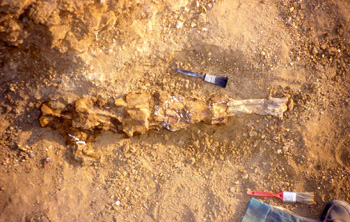
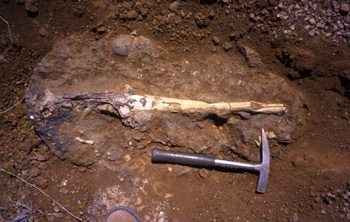
Skulls of Remingtonocetus, still embedded in the rock in which they were found. These skulls were found and excavated by a joint team led by Dr. Sunil Bajpai and Dr. Hans Thewissen in Kachchh, India.
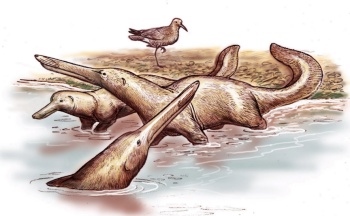
Reconstruction of the remingtonocetid Kutchicetus.
The reconstruction is based on the bones.
It was a small animal, no bigger than a river otter.
This illustration can be reproduced freely, but this statement has to be added to its caption:
Illustration by Carl Buell and taken from http://www.neoucom.edu/Depts/Anat/Thewissen/whale_origins/whales/Remi.html.
Further Reading:
Thewissen, J. G. M., and E. M. Williams. 2002. The early evolution of Cetacea (whales, dolphins, and porpoises). Annual Review of Ecology and Systematics 33:73-90.
Thewissen, J. G. M., and S. Bajpai. 2001. Whale origins as posterchild for macroevolution. BioScience 5:1037-1049.
Thewissen, J. G. M., and S. Bajpai. 2001. Dental morphology of the Remingtonocetidae (Cetacea, Mammalia). Journal of Paleontology 75:463-465.
Bajpai, S., and J. G. M. Thewissen. 2000. A new, diminuitive whale from Kachchh (Gujarat, India) and its implications for locomotor evolution of cetaceans. Current Science (New Delhi) 79:1478-1482.
Thewissen, J.G.M., and S.T. Hussain. 2000. Attockicetus praecursor, a new remingtonocetid cetacean from marine Eocene sediments of Pakistan. Journal of Mammalian Evolution 7:133-146.
SOME MODERN WHALES
Adapted from figures in Peter Evans' The Natural History of Whales & Dolphins, 1987MYSTICETES (Baleen Whales)

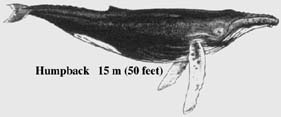

ODONTOCETES (Toothed Whales)
